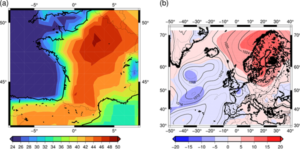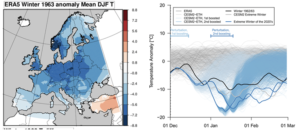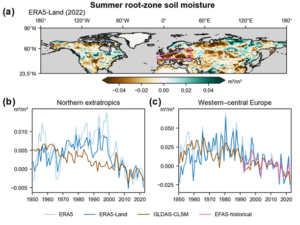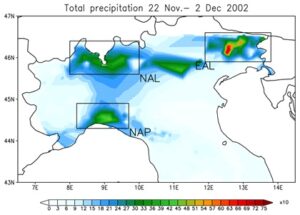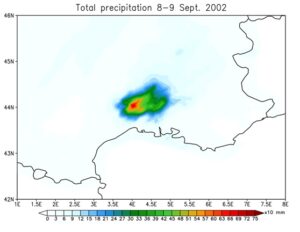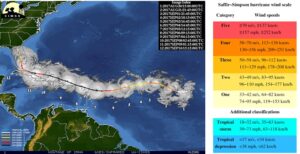Cold Outbreak in Europe
in spring 2021
The spring of 2021 showed anomalously low temperatures across large areas of Europe (see Figure 1). These extreme temperatures likely contributed to impacts in different sectors (energy, health, agriculture). In particular, several frost nights in early April in France caused damage to the regional wine industry as the cold temperatures occurred after anomalously warm temperatures in March, thus, right in the sensitive phase after bud-burst.
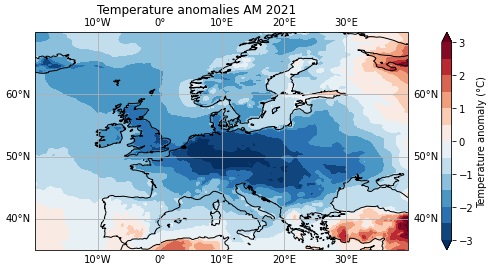
Figure1: Average temperature anomalies in Europe for April and May across Europe. Blue colours indicate that spring temperatures were lower than the long-term (1950-2020) average. (Data: ERA5 reanalysis)
Event definitions
Depending on the research objectives, XAIDA proposes different event definitions.
1. To study the physical drivers of the cold spring of 2021, XAIDA suggests defining the event using a “weather regimes” perspective. Weather regimes denote typical large-scale atmospheric circulation patterns, usually defined using cluster analysis of daily sea level pressure anomalies. XAIDA will define the most relevant spring weather regimes and further identify and analyse the dominant regimes responsible for the cold spring of 2021. This approach will allow us to study the full region of Europe at once, and, by applying varying persistence thresholds, also flexibly assess different relevant time-scales.
2. To study the impacts on the French wine industry of the cold spring 2021, we propose, following Vautard et al. (2021, https://www.worldweatherattribution.org/human-caused-climate-change-increased-the-likelihood-of-early-growing-period-frost-in-france/), to focus on central/northern France [-1°- 5°E; 46°-49°N], covering most of the grapevine agriculture areas of Champagne, Loire Valley and Burgundy. The relevant variables are daily minimum temperatures as well as growing degree days (GDD).
3. To study the more general impacts of the cold spring 2021 on vegetation, we will first develop a memory-aware machine-learning modelling framework of vegetation phenology based on near-surface and satellite remote-sensing data across central and eastern Europe. We will then use the model to estimate impacts of the cold spring on different growing season metrics and vegetation productivity. We will compare results with those of process-based vegetation models.
Objectives
XAIDA aims at :
1. improving the understanding of the physical drivers of this event. We will use causal networks to test and quantify the contribution of different proposed remote drivers (such as ENSO, the polar vortex) on cold spring temperatures in Europe. Cluster analysis will be applied to identify weather regimes.
2. understanding in what way observed and projected temperature changes (minimum, mean, variability and seasonality) can explain trends in frost nights after bud burst using statistical modelling.
3. understanding how observed and projected temperature changes will impact ecosystems during different phenological stages.
Study results
Preliminary results on objective 1 indicate that the strength of the winter-mean polar vortex is associated with the timing of spring vegetation growth in Europe and partly extends into summer. This relationship can be explained through weather regimes occurrences, with a weak polar vortex, for instance, favoring weather regimes associated with cold weather and hence later vegetation growth. The role of ENSO appears less clear and might include different pathways.
Using statistical modelling, using observations and 172 climate model simulations, Vautard et al (2023) showed that:
- Without human-caused climate change, the temperatures in April (or later in spring) would have been about 1.2°C colder. However, climate change has caused plants like grapevines to sprout earlier in the season. This leaves young leaves more vulnerable to cold conditions, as they face lower temperatures and longer nights typical of winter. This effect outweighs the warming caused by climate change.
- Frosts after the start of the growing season, like the one in April 2021, are now about 2°C colder compared to preindustrial times. This increase in frost severity is partly due to human-caused climate change.
- Climate models show that since preindustrial times, the coldest temperatures during the growing season have dropped by about 0.41°C on average. The likelihood of such damaging frosts has increased by 50% (ranging from 10% to 110%) because of climate change.
While the models accurately reflect the warming trends in spring’s lowest temperatures, they underestimate the increase in the severity of frosts during the growing season. This discrepancy is not yet fully understood.
Conclusion
Using statistical modeling, Vautard et al. (2023) found that, without human-induced climate change, spring temperatures would be about 1.2°C colder, meaning plants like grapevines would sprout later. However, climate change has caused earlier sprouting, making young plants more vulnerable to cold conditions. This shift has led to frosts after the start of the growing season, like the one in April 2021, being about 2°C colder than preindustrial times. While climate models capture the warming of spring’s lowest temperatures, they underestimate the increased frost severity, a discrepancy that is not yet fully understood.
Preliminary findings suggest however that the timing of spring vegetation growth in Europe is also linked to the strength of the winter-mean polar vortex influences, with a weaker polar vortex leading to colder weather and delayed growth.
The processes that control meteorological memory effects on phenology are not fully understood, but deep learning creates new opportunities to enhance the representation of vegetation phenological processes in land surface models through a hybrid modeling approach.
References
Liu, G., Migliavacca, M., Reimers, C., Kraft, B., Reichstein, M., Richardson, A. D., Wingate, L., Delpierre, N., Yang, H., and Winkler, A. J. (2024). DeepPhenoMem V1.0: deep learning modelling of canopy greenness dynamics accounting for multi-variate meteorological memory effects on vegetation phenology, Geosci. Model Dev., 17, 6683–6701, https://doi.org/10.5194/gmd-17-6683-2024
Vautard, R., van Oldenborgh, G. J., Bonnet, R., Li, S., Robin, Y., Kew, S., Philip, S., Soubeyroux, J.-M., Dubuisson, B., Viovy, N., Reichstein, M., Otto, F., and Garcia de Cortazar-Atauri, I. (2023). “Human influence on growing-period frosts like in early April 2021 in central France”, Nat. Hazards Earth Syst. Sci., 23, 1045–1058. https://doi.org/10.5194/nhess-23-1045-2023
 This project has received funding from the European Union’s Horizon 2020 research and innovation programme under grant agreement No 101003469.
This project has received funding from the European Union’s Horizon 2020 research and innovation programme under grant agreement No 101003469.

